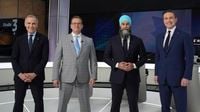As Canada approaches its pivotal 2025 federal election, the political landscape is marked by a tight race between the Liberal Party, led by former Bank of Canada governor Mark Carney, and the Conservative Party, headed by Pierre Poilievre. Recent polling data indicates that the Liberals hold a slight edge, but the outcome remains uncertain as the election date nears.
According to a Forum Research poll conducted on April 27, 2025, the Liberals are at 43% compared to the Conservatives at 39%. This trend is echoed by Nanos Research, which reports similar numbers with the Liberals at 43% and the Conservatives at 40%. Mainstreet Research projects that the Liberals could secure approximately 189 seats in the House of Commons, giving them a 70% chance of forming a majority government. In Canada, 172 seats are required for a majority in the 343-seat House of Commons.
The electoral map reveals distinct regional support patterns. The Liberals maintain strong backing in Quebec and Atlantic Canada, while leading by about seven percentage points in the crucial Ontario region. Conversely, the Conservatives are particularly strong in Alberta and the Prairie provinces, with British Columbia emerging as a key battleground.
Both the New Democratic Party (NDP) and the Bloc Québécois have seen declines in their support, which may benefit the Liberals, especially in Quebec and British Columbia. Carney, who took over the Liberal leadership in March 2025 following Justin Trudeau's resignation, has leveraged his extensive economic expertise to position the party as a steady hand during these uncertain times. His approach to U.S. relations and economic management resonates with many voters, although some Canadians express fatigue with Liberal governance after nearly a decade under Trudeau.
On the other hand, Conservative leader Poilievre has focused his campaign on economic affordability and public safety, gaining traction particularly in Western Canada. However, his confrontational style on cultural issues and U.S. relations has reportedly caused some centrist voters to hesitate. As the election draws closer, the dynamics of the campaign continue to evolve, with both leaders making their cases to the electorate.
In a recent debate, Carney and Poilievre presented starkly different visions for Canada's future. Carney has proposed a comprehensive economic strategy that includes significant investments in various sectors. Notably, his plan for the automotive industry includes a $2 billion fund aimed at boosting domestic vehicle production, while his agricultural policy features a $200 million fund to enhance local food processing capabilities.
Moreover, Carney's technology sector proposals include expanding research and development tax credits and creating a Canada patent box to protect intellectual property. He has also outlined a $25 billion financing initiative for prefabricated housing and a $25 billion export credit facility to bolster trade infrastructure.
In contrast, Poilievre’s platform, while promising, is less detailed and prescriptive. His key proposals include waiving capital-gains tax for any proceeds from asset sales reinvested in Canada and waiving the GST on domestically made vehicles. However, many observers note that his plans lack the specificity that Carney's do, leaving some voters uncertain about the Conservative agenda.
Complicating the electoral landscape is the influence of former U.S. President Donald Trump, whose recent comments and policies have sparked a wave of Canadian patriotism. Trump has repeatedly suggested that Canada should become the “51st state,” a notion that has galvanized many Canadians against perceived American overreach. This sentiment is reflected in recent polling, where 77% of Canadians expressed an unfavorable opinion of Trump.
As the election date approaches, the stakes are high. A POLITICO/Focaldata poll conducted from April 18 to April 23 found that Trump was a top concern for about two in five Canadian voters, second only to the cost of living, which three in five cited as their primary issue. With Election Day set for October 20, 2025, and early voting already underway, the race is on to capture the public's trust—and the keys to Canada's future.
Political analysts suggest that the election could define Canada’s direction for the next decade. Carney represents a continuation of centrist liberalism, while Poilievre advocates for a sharp conservative turn. Jagmeet Singh of the NDP offers a progressive alternative, emphasizing social justice and equity.
In addition to the main party leaders, several noteworthy candidates are shaping the election narrative. Chrystia Freeland, a former Deputy Prime Minister, remains a key figure in the Liberal Party, while Leslyn Lewis is emerging as a significant voice within the Conservative Party. Annamie Paul, the former Green Party leader, is running as an independent, focusing on issues of racial equity and democratic reform.
Key election issues driving the 2025 race include affordability and inflation, climate change, immigration and security, healthcare, and national unity. As campaigning intensifies, voter turnout is expected to rise, particularly among younger voters and new Canadians. With both parties vying to present their visions for the future, Canadians are faced with crucial decisions that could reshape the political landscape.
As the final days of the campaign unfold, both Carney and Poilievre are making their cases to the electorate, each hoping to secure a mandate to lead Canada through the challenges ahead. The outcome of this election will not only determine the next prime minister but also set the course for Canada’s political and economic future.





